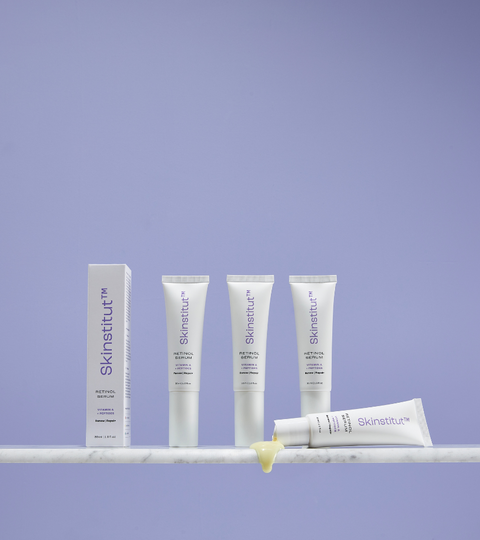We don’t like to play skincare favourites, but we’re big fans of Retinol. Not only is it widely studied and clinically proven, it treats myriad skincare concerns, from lines and wrinkles to acne and blackheads – and beyond.
But with great power comes great responsibility – Retinol is proven to work, but it’s a powerful ingredient that requires a level of care, so it’s important to know what’s best for your skin. Which is where we come in. Scroll down for an explanation of exactly what Retinol is, how it works biologically with the skin, and how to integrate it into your routine for incredible results, minus any adverse effects.
What Is Retinol?
Retinol is a derivative of Vitamin A: the blanket term for ingredients derived from Vitamin A is ‘Retinoid’.
What some people might not realise is that there are a few different Retinoid categories (including Retinol), and they’re classified based on their strength.
Here’s a quick explainer, ranging from the highest strength to the
lowest:
- Retinoic Acid (highest strength)
This is Vitamin A in its purest form, meaning it communicates directly with our skin (i.e. all Vitamin A derivatives need to convert to Retinoic Acid to have an effect on the skin). In Australia, pure Retinoic Acid is sold via prescription only.
- Retinaldehyde or Retinal (mid-to-high strength)
Next up we have Retinaldehyde, a Retinoid that requires one ‘conversion’ to transform into Retinoic Acid.
- Retinol (mid-strength)
Moving on to Retinol; requiring two conversions to become Retinoic Acid, this type of Vitamin A is very popular in skincare – and with us!
- Retinol Esters (low strength)
Finally, we have Retinol Esters, a gentler form of Vitamin A that takes three or more conversions to turn into Retinoic Acid.
It’s worth noting that for every ‘conversion’ the ingredient loses some of its strength in the process. This isn’t necessarily a bad thing – it’s more dependent on your skin type, any complexion concerns you have, and the formulation in question.
What Are The Benefits Of Retinol?
Where do we even begin? Retinoids, including Retinol, are one of the most widely studied ingredient categories in skincare. There is abundant clinical evidence proving just how effective Retinoids are when it comes to improving complexion health.
The main drawcard is that Retinol regulates cell turnover, a natural skin process but one that slows as we age. When our cells aren’t constantly being replaced, skin can look dull, with a rough texture and pronounced signs of ageing. Cell build-up is also one of the main risk factors when it comes to acne. Because Retinol brings fresh, undamaged cells to the surface, it’s equally effective in the treatment of discolouration and some types of pigmentation.
Retinol also works to support collagen and elastin formation, improving the skin’s internal support network. The results? Fewer fine lines, plumped wrinkles and a more youthful appearance overall.
Who Should Use Retinol, And Where Does It Fit In A Wider Routine?
Because of its efficacy, Retinol is a smart choice for anyone with a textbook skin concern (this includes signs of ageing, pigmentation, sun damage, large pores, acne and rough texture). The only exception would be those with highly sensitive skin, and it’s not recommended for anyone pregnant or breastfeeding.
If you’re new to Retinol, go slow. Start by applying it one evening a week, on clean, dry skin, and gradually build up the frequency. Because Retinol turbo-charges cell turnover, some people experience adverse effects when it’s initially introduced. You might notice flaking, slight redness or a ‘purge’, which occurs when acne under the surface is rapidly expelled through the epidermis. But rest assured it’s just a sign the product is working its magic.
Seasoned users can apply Retinol every night or every second night; those with thicker, oily, or acne-prone complexions can use daily, whereas those who exhibit signs of dryness might like to alternate with more nourishing products. Another caveat is exfoliation – if you’re using AHAs in your routine, it’s best not to combine the two. Instead, alternate them on different evenings.
There are two golden rules when using Retinol:
- Use your SPF daily, as Retinol can make your skin more photosensitive.
- Follow up with a hydrator such as Moisture Defence Normal Skin.
Find Your Perfect Skinstitut Retinol
Our OG formula, Retinol Serum, contains a 1.25% encapsulated form of Retinol that slowly releases to ensure you see benefits without irritation. The lightweight serum is boosted with Peptides to enhance firming benefits, as well as plant-based extracts to protect the skin.
It’s lightweight, absorbs quickly and can be used by most skin types including dry, normal, oily, pigmented and acne-prone.
Apply Retinol Serum to clean, dry skin after cleansing at night, but before other serums and your moisturiser. A pea-sized amount is plenty. You should start to notice a visible improvement within six to eight weeks of use.
Expert Reveal Retinol Face Oil
If you have mature skin or love the feeling of a nourishing face oil, Expert Reveal Retinol Face Oil is for you. The silky formula contains 0.9% Retinol as well as Retinyl Palmitate to create deep change within the skin without disrupting barrier function, while plant oils like Macadamia and Sunflower simultaneously soften, restore and replenish. Essentially, you get the benefits of Retinol plus nourishment.
Use it on clean skin, a few nights a week before sealing in with your moisturiser.
Want more skintel on our favourite proven cosmeceutical ingredients? Read our blog on Vitamin C right here.

















